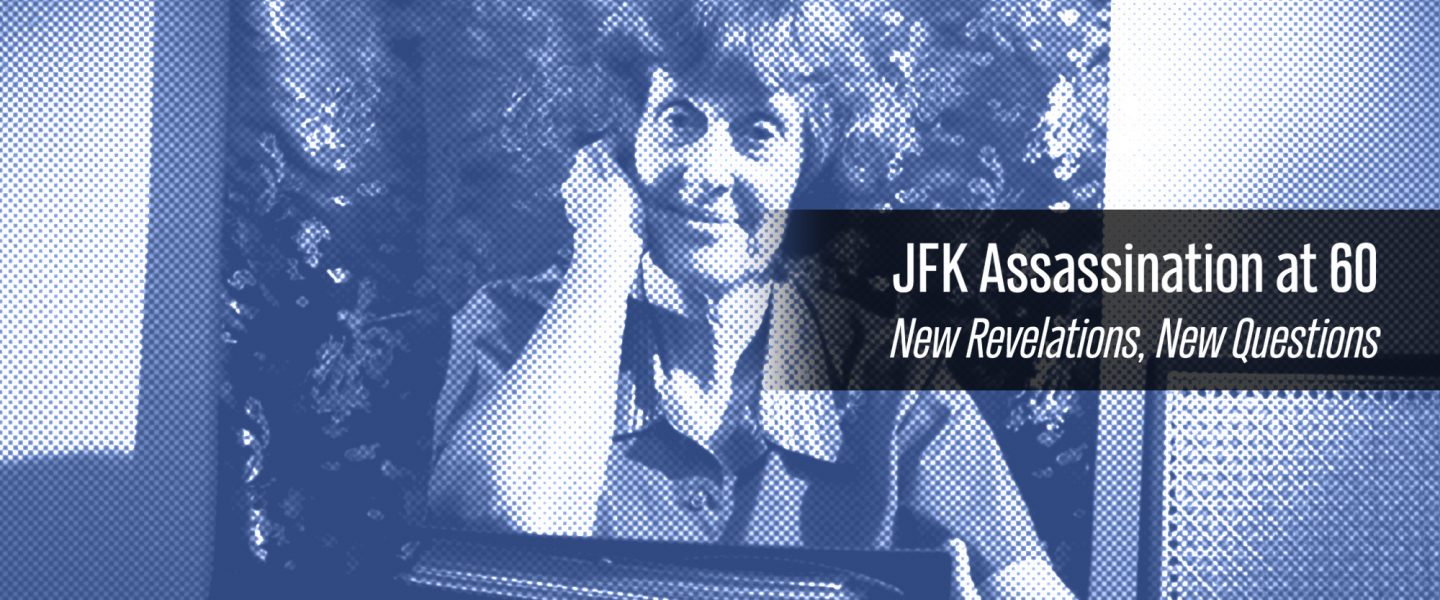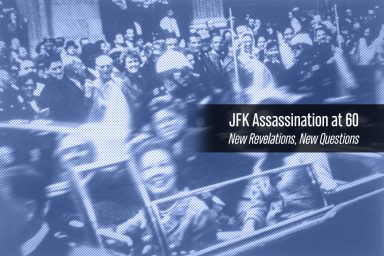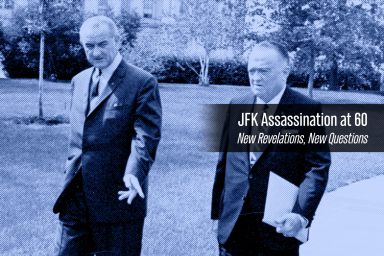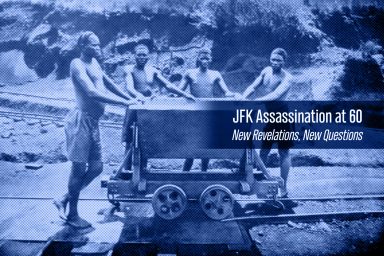Will she ever tell what she knows?
|
Listen To This Story
|
Ruth Paine is an unassuming 91-year-old living in a Quaker retirement community in Northern California — and she may hold vital secrets to what has been called “the crime of the century.”
With 60 years having passed since the deaths of John F. Kennedy and Lee Harvey Oswald, only a handful of critical witnesses are still alive. Of that small and ever-dwindling group, Ruth is arguably the single most important.
Back in the fall of 1963, the pregnant Russian wife of Lee Oswald — the man who would soon be charged as the alleged assassin of JFK — was living in the home of the 31-year-old Ruth.
The Quaker woman was separated from her husband, Michael Paine, at the time, which allowed for Marina to move into her home. Although Ruth did not extend the invitation to Lee, he regularly spent weekends there.
More importantly, Ruth was instrumental in helping him obtain employment at the Texas School Book Depository (TSBD) building in late October 1963, forever altering the country and the world.
This, despite the fact that the TSBD Company — for which the building would become infamous — was in a down season and laying off employees.
The then-owner of the TSBD building, it should be noted, is himself a highly suspicious character in the JFK assassination story — go here for WhoWhatWhy’s article on D.H. Byrd.
Because of their relationship with the Oswalds, Ruth and her husband were asked thousands of questions by the Warren Commission, the investigative panel formed in the aftermath of Kennedy’s murder. Ruth herself was asked more questions than any other individual witness.
Although absolved by the commission of any involvement in Kennedy’s murder, the couple has remained the target of intense suspicion by those who don’t buy the Warren Report’s conclusion that Oswald was a lone gunman who killed JFK.
Some of that suspicion stems from the Paines’ respective familial backgrounds and their suggestive links to the world of espionage and intelligence gathering, leading many to wonder if there’s more to Ruth and Michael than the public image of them as innocent do-gooders who made the unfortunate mistake of befriending a disgruntled ex-Marine and his Russian wife.
***
As I began my own initial research into the JFK case several years ago, I was repeatedly confounded by the Paines. They were objectively not your average couple living in 1960s Dallas suburbia, from which I myself hail. Their story was crying out for a talented filmmaker to come along and tell it.
In 2017 I was delighted to stumble across The Assassination and Mrs. Paine, a documentary that was in production at the time that examines this complicated woman and the decades-long speculation that has swirled around her. (I got in touch with the director, Max Good, and then donated money to the project as well as providing some research.)
Good, whose first film, Vigilante, Vigilante, played at a number of festivals and appeared on Netflix, first met Ruth in 2014 when he was a graduate student at Stanford University’s film school. While ruminating on ideas for his MFA thesis, Good, a recent initiate into the JFK mystery, discovered that she lived just up the road in a retirement home for Quakers. He took a chance and called her. To his surprise, she agreed to sit down for a series of filmed interviews. Those interviews became his 20-minute master’s thesis film and now form the backbone of a feature-length documentary about her.
Released in April 2022 (and now streaming on various platforms) the film explores Ruth’s recollections about that tumultuous period of time so many years ago, while also examining why she has been a figure of such fascination and suspicion.
Texas Yankees
Despite living in a modest home in a nondescript suburb of Dallas, both Ruth and Michael Paine (who died in 2018) were well-heeled individuals from established families back East. This is especially true of Michael, who hailed from a lineage of Forbeses, Cabots, and Paines — families with deep colonial roots in New England.
His great-great grandfather was the celebrated poet/philosopher Ralph Waldo Emerson, and a great uncle was the governor general of the Philippines after the Spanish-American War. A more distant relative on his father’s side was Robert Treat Paine, one of the signers of the Declaration of Independence.
The couple made their way to Texas in 1959 when Michael was hired as a research engineer for Bell Helicopter. Lacking a college degree, much less one in engineering, it probably didn’t hurt that his stepfather was none other than Arthur Young, the inventor of the first commercially successful helicopter. Young sold his patent to Bell in the early 1940s, paving the way for a brave new world of rotary-wing aircraft.
Because Michael was a Unitarian and avowed pacifist, his employment at Bell has struck many as curious. A few years ago I questioned Ruth about this seeming contradiction, following a speech she gave in her former home city of Irving, TX. Her response was rather blasé, as if there were nothing substantive to my inquiry, but the fact remains that her husband was helping design weapons of war for a company that made millions during the US’s involvement in Vietnam. The Bell 47, of M.A.S.H. fame, and the Bell UH-1 “Huey,” synonymous with the Vietnam War, are among the most iconic helicopters of all time.
Equally strange is that Michael only met Oswald a handful of times, but on almost every occasion they spent their time together at local meetings of the ACLU as well as the John Birch Society — two groups at opposite ends of the political spectrum. Odd behavior for someone with a security clearance at a major defense contractor.
To all appearances, they were spying on one or both of these groups.
Intelligence and the Left
During the Cold War, US national security agencies made frequent use of the anti-communist left — including religious groups like the Quakers and Unitarians — to gather intelligence and inform on possible communists or Soviet spies within the burgeoning labor movement and other progressive organizations.
Declassified CIA and FBI documents strongly suggest that Ruth’s own father, William Hyde, was one of these individuals tasked with gathering information for the CIA.
Hyde and his wife were longtime activists in the cooperative movement, which was seen as a potential third way that could harness the best attributes of capitalism and collective ownership. They were also strong supporters of the moderate socialist Norman Thomas for president. Thomas himself was later revealed to have been funded by the CIA, a fact of which he claimed no knowledge.
An executive for Nationwide Insurance, Hyde also worked for USAID (United States Agency for International Development), a well-known CIA cover. In fact, declassified JFK records reveal that Hyde was considered by the CIA in 1957 for covert use in Vietnam, with the goal of establishing educational cooperatives there. Although not chosen (at least according to the memos), he was given a favorable review by the agency. Ruth herself admits the close alliance between the two agencies but does not believe her father ever worked for the CIA.
Ruth’s sister, Sylvia Hyde Hoke, worked for the CIA as a psychologist as far back as 1954; a Virginia directory in 1961 listed her as still employed by the agency. Sylvia’s husband, John Hoke, also worked for USAID and his applications to work for the CIA were declassified in 2017. It appears that he wasn’t hired.
These multiple links to the CIA suggest the Hyde family was at the least a trusted source of information to the government during the Cold War. Whether Ruth was also recruited as an operative is still an open question.
The Other Ruth
One of the more compelling aspects of the entire Paine story — and there are many — is the fact that Michael’s mother, Ruth Forbes Young, was a close friend of a woman named Mary Bancroft, an OSS spy in Switzerland during World War II working under the watchful eye of future CIA Director Allen Dulles. Bancroft carried on an affair for several years with the wily spymaster, and the two would even be invited by Ruth Young to stay on her family’s private island, a sprawling 7-mile hideaway off Cape Cod, held for well over a century by the Forbes clan from which she descended.
Bancroft’s family once owned The Wall Street Journal and even its parent, Dow Jones & Company — only to sell their stake in the Journal to Rupert Murdoch’s News Corporation in 2008.
This was the world that Michael came from, and Bancroft pointed out these odd ”coincidences” in letters she wrote to Dulles while he was serving on the Warren Commission. Dulles, whom JFK fired after the Bay of Pigs disaster, found his way onto the commision that was tasked with investigating the death of the very man that ended his career.
In The Devil’s Chessboard: Allen Dulles, the CIA, and the Rise of America’s Secret Government, David Talbot writes:
As the Warren Commission went about its business, Mary wrote Dulles chatty letters about the Forbes and Paine families, and their horrified reaction to the events in Dallas, as if she were back in wartime Switzerland and still filing espionage reports. Bancroft reminded Dulles that she had known Michael Paine’s mother “extremely well” for over forty years and had spent summers with her on Naushon Island. She enumerated the families’ many lovable oddities and their sense of grand entitlement. “I was always fascinated by those proper Boston homes — and by the Forbes family at Naushon where I spent a lot of time,” wrote Mary in a March 1964 letter to Dulles.
In addition to her relationship with Dulles, Bancroft was a frequent mistress to yet another powerful man with links to Kennedy’s murder, Henry Luce, founder and publisher of Time magazine and the publishing giant that grew out of it. Luce’s company somehow managed to purchase the Zapruder film — the single most important piece of evidence documenting JFK’s death — and conceal it from the public for over a decade.
During a particularly candid moment in the Good documentary about her, Ruth concedes that she can understand how some might view these links with suspicion. But there’s nothing to them, she assures sarcastically. “My mother-in-law knew Allen Dulles, so obviously there’s a plot.”
While it’s true that guilt by association can be a slippery slope, it’s also true that Dulles is near the top of a long list of powerful people that the Kennedy brothers angered during their short stint in the White House.
JFK ended Dulles’s career after discovering that the then-CIA director had snookered him into green-lighting the Bay of Pigs. “The Old Man,” as Dulles was sometimes called, knew that the planned invasion of Cuba by CIA-trained expats was doomed to failure but assured the young president otherwise. Dulles, assuming that the small group of Cuban exiles would be no match for Castro’s military, was secretly hoping that the dire situation would convince Kennedy to send in air support — something JFK to which was adamantly opposed, and had already said as much to his intelligence and military advisers in the lead-up to the invasion.
The Letters
Despite all the questions she has answered and all the media appearances that she has made over the years, there are still lingering doubts about Ruth’s candor as it relates to her actions before, during, and after November 22, 1963.
The doubts revolve around two intriguing pieces of evidence that have become known as the Walker note and the Kostin letter.
About a week after the assassination, Ruth turned over a Russian book of Marina’s that hadn’t been taken in searches of the Paine home. In that book, the Secret Service found a note that became the premiere piece of evidence to accuse Oswald of having earlier taken a shot at prominent right-winger Maj. Gen. Edwin Walker.
The Warren Commission and establishment historians ever since have cited the Walker shooting ad nauseum as a precedent demonstrating Oswald’s propensity for violence and assassination. Of course, the details of the Walker shooting have come under critical scrutiny by JFK researchers, just like every major contention of the Warren Commission.
The Kostin letter involves an even more damning incident — a curious interchange between Ruth and Oswald. What we know of this incident comes from the testimony of Ruth herself. About 10 days before the assassination, Oswald borrowed her Cyrillic-alphabet typewriter and began typing out a letter to the Soviet Embassy.
Ruth says that Oswald acted suspiciously while typing and that she later took a rough draft of the letter that he left sitting on the desk. She copied the letter, and held on to it with the intention of handing it over to the FBI the next time she saw them. The FBI had in fact visited the Paine home twice before in the months preceding the assassination. Oswald wasn’t there either time but Ruth had spoken to the FBI about him. As a prior defector to the Soviet Union, Oswald was under close scrutiny by the authorities.
Ruth did hand the letter over to the FBI on November 23, after failing to disclose it to the Dallas police who had searched her home on the 22nd. The contents of the Kostin letter were used to tie Oswald to a visit to the Soviet Embassy in Mexico City, where he allegedly met with a KGB assassination specialist.
The problem with this spectacular information is that the CIA’s own photographic and audio surveillance of the Soviet Embassy in Mexico City revealed that the “Oswald” who supposedly conferred with the KGB agent at the embassy was being impersonated by another individual. We know this because J. Edgar Hoover discussed it with Lyndon Johnson the day after the assassination.
Related: JFK Murder: Evolving Strategies for Damage Control
The Soviets themselves called the Kostin letter a “provocation” and believed the US forged it to use as a pretext for starting a war with Russia or Cuba — or both.
In a secret internal memo from a collection of previously withheld KGB documents, the Soviet ambassador to the US, Anatoly Dobrynin, wrote the following:
One gets the definite impression that the letter was concocted by those who, judging from everything, are involved in the president’s assassination. It is possible that Oswald himself wrote the letter as it was dictated to him, in return for some promises, and then, as we know, he was simply bumped off after his usefulness had ended.
Thus, we have Ruth admitting that she was essentially informing on Oswald to the FBI and handing over one of the most controversial and explosive pieces of evidence in the entire case.
Conspirator or Dupe?
So what does this all mean? Is Ruth hiding secrets to one of the greatest murder mysteries of our time? And if so, what are these secrets? Were she and her husband told to keep an eye on Oswald and his wife by one of the national security agencies monitoring the recently-returned couple — something she adamantly denies?
For sake of argument, suppose Ruth was not a naive housewife but some kind of intelligence agent (whether formally or informally). This leads to the unavoidable question: If there was indeed a conspiracy to murder JFK and blame Oswald, was Ruth a witting participant? Or just an intelligence asset who was duped into playing a role in a masterfully clever plot that the Warren Commission entirely missed?
There’s also the matter (again assuming that her relationship with the Oswalds was at the behest of someone in national security) of Ruth being forced to keep such explosive secrets, whatever they may be, locked inside her for 60 years. Not an enviable situation.
Also relevant is the man who introduced the Oswalds to Ruth, George de Mohrenschildt. One of the most intriguing characters in this whole mystery, he was a part of the White Russian community in Dallas/Fort Worth who helped look after the Oswalds when they settled there in the summer of 1962. Later, he told investigators that he was asked by a local CIA officer to keep an eye on Oswald after his return from behind the Iron Curtain.
In 1977, just before he was to be questioned by a member of the House Select Committee on Assassinations (HSCA), he died under questionable circumstances from a shotgun blast to his head.
Did de Mohrenschildt, whose own intelligence connections are seemingly endless, pass off his duties to Ruth and Michael Paine?
Whatever the truth is, the Paines have ceaselessly insisted on their characterization of Oswald as a pathetic waif with homicidal tendencies — despite their very limited interactions with him — and their unwavering acceptance of him as the lone culprit in the JFK assassination.
Whatever Ruth may or may not know about a deep conspiracy to kill our 35th president, hopefully the story of her intersection with that monumental tragedy can serve as a catalyst for renewed interest in the Kennedy case.
JFK assassination files related to the Paines remain classified to this day.
About the JFK Assassination Series
This series was inspired by an ongoing project of WhoWhatWhy Founder and Editor-in-Chief Russ Baker to produce a definitive, meticulous, book-length investigation of Kennedy’s death.
Click here for the introduction to the series. To see all the articles in the series, click here.
If you have information to bring to our attention about any aspect of the JFK assassination — or are with the media and interested in covering or reproducing our work or inviting Mr. Baker to appear on a program — please click here.
If you would like to be on a mailing list to receive news of the book, click here.





